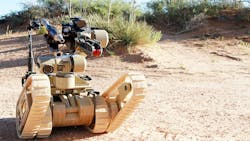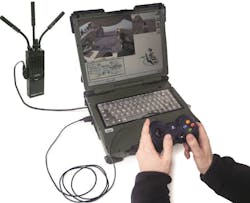U.S. Army unmanned ground vehicle (UGV) experts choose common robot platform from FLIR for bomb disposal
WARREN, Mich. – U.S. Army unmanned ground vehicle (UGV) experts needed a large vehicle-transportable common ground robot platform to host a variety of explosive ordnance disposal (EOD) payloads. They found their solution from the FLIR Systems Inc. Unmanned Ground Systems (UGS) segment in Chelmsford, Mass. (formerly Endeavor Robotics).
Officials of the Army Contracting Command in Warren, Mich., announced a $109 million five-year contract to FLIR UGS last week to build the Common Robotic System-Heavy (CRS-H) to provide standoff capability to identify, render safe, and dispose of explosive ordnance and improvised explosive devices in military and homeland defense applications.
The CRS-H will host bomb-disposal payloads like pan, tilt, and zoom cameras, secure radios, radio relays to extend operational ranges, strong manipulator arms, cargo carrier rack, and operator control unit. FLIR acquired Endeavor Robotics earlier this year.
The FLIR CRS-H is based on the company's Kobra heavy-payload ground robot, which has a lift capacity of 330 pounds, and can reach upward with its manipulator as high as 11.5 feet.
Kobra uses the MPU5 radio operating on the Wave Relay MANET from Persistent Systems LLC in New York City, to form a robust ad-hoc network in which robots, operators, and observers operate together in quickly configured ground communications networks.
The CRS-H is expected to provide significantly enhanced capabilities in camera views, manipulator effectiveness, dexterity, arm extension and lift capacity, mobility, modularity, cyber security, and reliability over fielded heavy EOD systems.
The common robotic system-individual (CRS-I) man transportable robotic system increment 2 and the CRS-H, will make up a new family of Army explosive ordnance disposal robots.
The CRS-H is to replace the Army's Remote Ordnance Neutralization System robots. The contract calls for FLIR to build as many as 350 CRS-H systems, as well as to refurbish the robots, and provide spare parts, user training logistics, and test support.
On this contract FLIR Systems will do the work at sites to be determined with each order, and should be finished by November 2024. For more information contact FLIR Unmanned Ground Systems online at www.flir.com/uis/ugs, or the Army Contracting Command-Warren at https://acc.army.mil/contractingcenters/acc-wrn/IES.html.
About the Author
John Keller
Editor-in-Chief
John Keller is the Editor-in-Chief, Military & Aerospace Electronics Magazine--provides extensive coverage and analysis of enabling electronics and optoelectronic technologies in military, space and commercial aviation applications. John has been a member of the Military & Aerospace Electronics staff since 1989 and chief editor since 1995.

